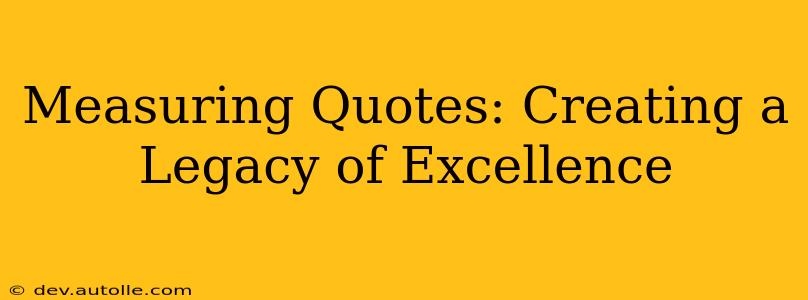In the dynamic world of business, accurate quote management is paramount. A well-structured quoting process isn't just about securing deals; it's about building a legacy of excellence, fostering strong client relationships, and ensuring profitability. This article delves into the critical aspects of measuring the effectiveness of your quoting process, helping you refine your strategies and achieve sustained success.
What Key Metrics Should You Track for Quote Performance?
Understanding which metrics to track is the first step towards optimizing your quote process. Key performance indicators (KPIs) should reflect your overarching business goals. Some essential metrics include:
- Quote-to-Order Rate: This crucial metric measures the percentage of quotes that convert into actual orders. A low rate indicates potential issues in your pricing, sales process, or product offering.
- Average Quote Value: Tracking the average value of your quotes helps you understand your pricing strategy's effectiveness and identify opportunities for upselling or cross-selling.
- Quote Cycle Time: This metric measures the time it takes from quote creation to acceptance (or rejection). A long cycle time can indicate inefficiencies in your process or communication gaps.
- Win Rate by Sales Rep: Analyzing individual sales representative win rates helps identify top performers and areas needing improvement in training or support.
- Quote Abandonment Rate: Understanding why potential clients abandon their quotes is critical. This often points to issues with pricing, complexity, or the overall customer experience.
- Customer Acquisition Cost (CAC) per Quote: This metric helps you understand the cost of acquiring a customer through the quoting process. Analyzing this metric allows you to optimize your resources and improve efficiency.
How Do You Calculate Quote-to-Order Rate?
Calculating your quote-to-order rate is straightforward:
Quote-to-Order Rate = (Number of Orders / Number of Quotes) x 100%
For instance, if you sent out 100 quotes and received 25 orders, your quote-to-order rate is 25%. This relatively low rate would signal a need for improvements in your process.
What Are the Common Reasons for Low Quote-to-Order Rates?
Several factors can contribute to a low quote-to-order rate. Understanding these common pitfalls is essential for improvement:
- Pricing Issues: Uncompetitive pricing, hidden costs, or unclear pricing structures can deter potential clients.
- Poor Communication: Lack of responsiveness, unclear explanations, or ineffective follow-up can lead to quote abandonment.
- Complex or Lengthy Quotes: Overly complex quotes with excessive jargon or lengthy processes can overwhelm potential clients.
- Ineffective Sales Process: A poorly defined sales process can lead to missed opportunities and decreased conversion rates.
- Product/Service Mismatch: If your offering doesn't meet the customer's needs, it's unlikely to result in an order.
How Can You Improve Your Quote-to-Order Rate?
Improving your quote-to-order rate requires a multi-pronged approach:
- Refine your pricing strategy: Conduct market research to ensure competitive pricing and clearly communicate your value proposition.
- Streamline your quoting process: Simplify your quote creation and approval workflows to reduce cycle times.
- Enhance communication: Provide prompt and clear responses to client inquiries, and follow up consistently.
- Improve sales training: Equip your sales team with the skills and knowledge to effectively present your offerings and address client concerns.
- Invest in CRM software: A robust CRM system can help manage your quotes efficiently and track key metrics.
What Tools Can Help Track Quote Performance?
Numerous tools can assist in tracking quote performance. Customer Relationship Management (CRM) systems like Salesforce, HubSpot, and Zoho CRM offer comprehensive features for quote management and performance analysis. Other specialized quoting software solutions are also available depending on your specific needs and industry.
By diligently tracking these key metrics and proactively addressing any weaknesses, you can dramatically improve your quote-to-order rate, build stronger client relationships, and ultimately create a legacy of excellence for your business. Remember, consistent monitoring and adaptation are key to continuous improvement in the ever-evolving business landscape.

